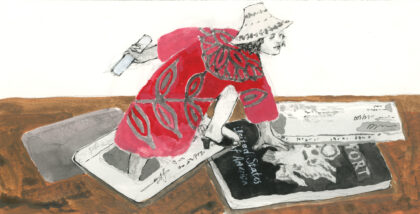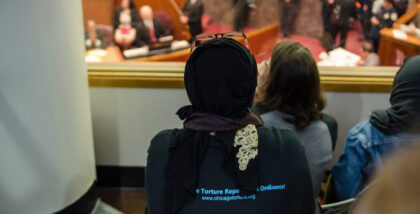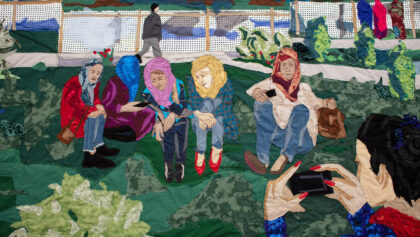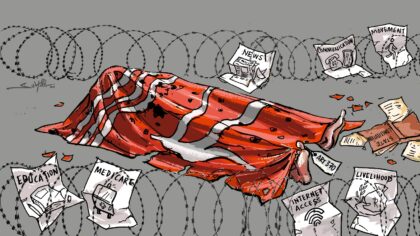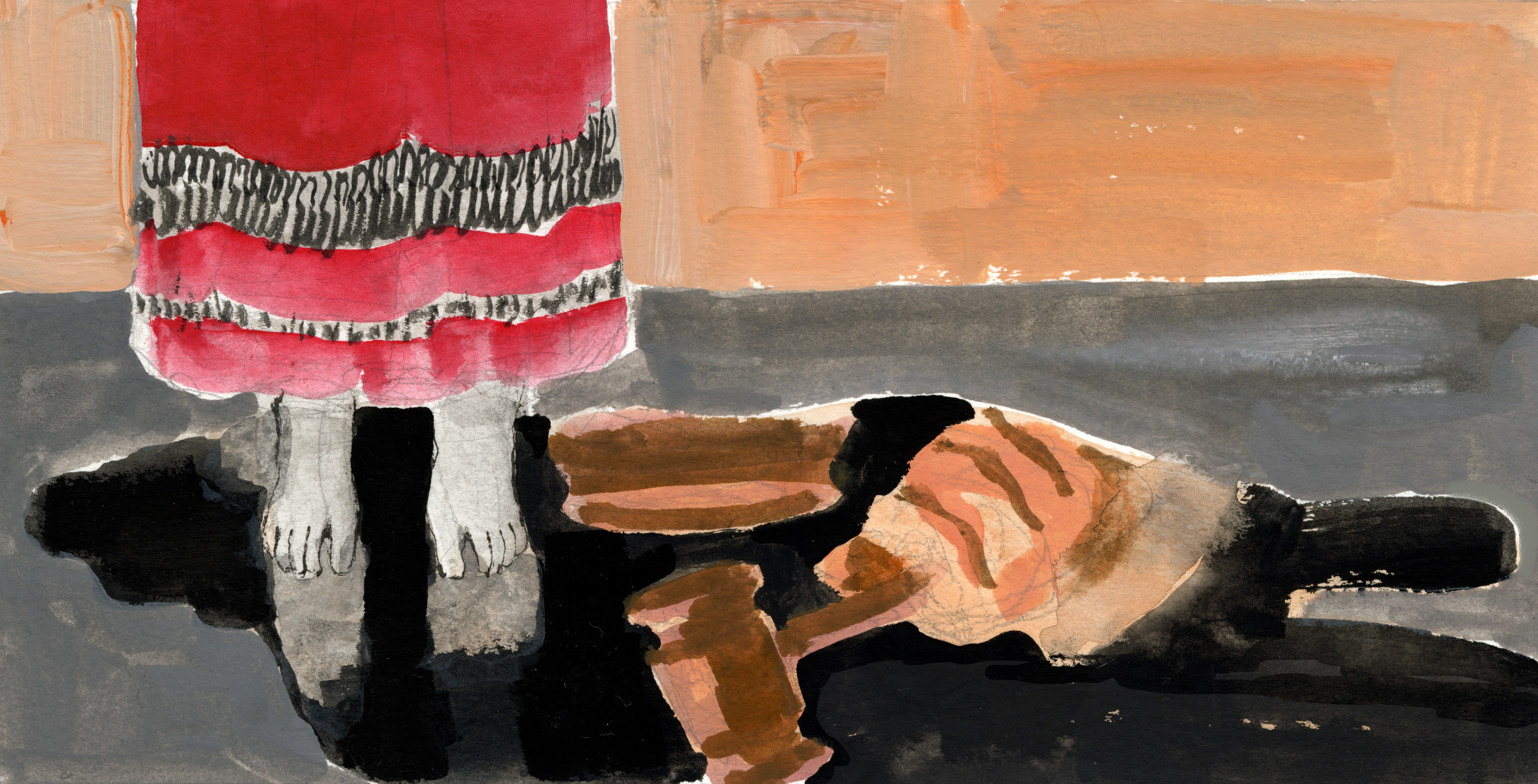 Illustration: Jia Sung
Illustration: Jia Sung
The Dawoodi Bohra community in Karachi had its own housing society, its own medical clinics, mosques, and even its own limited bus service. This housing society, home to many in the community who had migrated to Pakistan following Partition in 1947, was not far from where I grew up. Sometimes when my father would park the car outside a store near one of their homes or mosques, I would watch the women get in and out of the buses. To me, a child of six or seven, they looked like confections, always in some pretty pastel blue or green or pink. They wore a particular kind of outfit, an outer covering a bit like a burka, but not the usual kind worn by other women in the city. Theirs was made up of three pieces: a skirt, a cloak that covered the upper half of the body, and a headpiece that tied under the chin. Often the borders of the three pieces would be delicately embroidered with floral patterns or yards of lace or ribbons. Whatever lay beneath the garments, from the outside and en masse, these women were bouquets of colors, and I wished I could dress like them.
As I grew older, the children of these women became my friends. Of these friends as well I was envious. We all went to the same girls school, a place of rules and restrictions enforced by earnest and stolid teachers. But it was soon obvious that where life beyond school was concerned, Bohri girls enjoyed many more freedoms than the average Sunni Muslim girl like myself. They were encouraged to work outside the home—their mothers and aunts and sisters all did. And there were other, even more coveted freedoms. While I was cloistered up and forbidden to even talk to boys, they faced few such restrictions. Male and female contact did not ruffle feathers; it seemed, instead, a matter of course. Compared to the rest of Pakistan, Muslims belonging to the Bohra community, a small Shiite sect, were considered liberal and progressive.
*
I first saw Dr. Jumana Nagarwala’s picture in the New York Times in the spring of 2017. It is an image from the website of her workplace, a Detroit hospital. In it, she smiles at the camera, and the pastel blue of her special Bohra headcovering is visible, tied securely under her chin. I had not thought of Bohra Muslims for several years. The last time would probably have been in 2015, when one of the Bohra mosques in Karachi had been bombed. Since they practiced Shiism, the Bohris were considered heretics by the Taliban and the other Islamist groups that roamed and reigned in Karachi. Within the pure Sunni Pakistan that the Islamists wanted to realize, the Bohris could not belong.
But the story of Dr. Jumana Nagarwala did not have to do with a bombing. “Michigan Doctor is Accused of Genital Cutting of 2 Girls,” read the headline. Most of the information in the article was derived from a complaint filed by the federal government against Nagarwala. The allegations were terrifying. Nagarwala, an emergency room physician in Detroit, had allegedly performed a “genital cutting” procedure on two seven-year-old girls. Known as khafz, the Arabic-derived word for female circumcision, the ritual is said to have originated in the teachings of the Bohra community, whose current leader, Syedna Muffadal Saifuddin, has endorsed the practice (though has also urged diaspora Bohras to abide by the law of the land). Beyond the community, the practice is not prevalent in South Asia. Indeed, I had never heard of it until I migrated to the West.
The details in Nagarwala’s indictment are chilling. In February 2017, the two girls were spirited away by their parents from their homes in Minnesota to a hotel in Michigan. There, an evening trip to the doctor was explained to the girls as a way to ease a tummy ache. And then, the dark crime itself—Female Genital Mutilation (FGM), carried out by a female doctor while the girls lay on an examination table, legs apart. The evidence of the crime is on their bodies; the scar tissue and the disfiguration indictments against what had been done to them.
The news caused an uproar. In an America with whetted appetites for hating Muslims, here were more reasons. Representatives of Muslim organizations, when they did get a chance to appear on cable television, underscored the truth that FGM has nothing to do with Islam, and is not supported by any religious directive. It was a cultural and not a religious practice, they emphasized earnestly.
Hardly anyone seemed to notice the difference. Here was a doctor entrusted with health and healing now committing a criminal act on minors, subjecting them to a human rights violation. Nagarwala was charged, taken into custody, jailed, and denied bail. She posed a flight risk, the judge said; prosecutors agreed, calling her “a danger to the public.” It took five months, after members of her community posted a $4.5 million bond (assembled from real estate holdings), before she was released and confined to home detention.
Do anti-FGM campaigns provide cover for yet another invasion of the bodies of Muslim women?
When I read about the decision, I was shocked but also perplexed. It seemed unfathomable that this kindly looking doctor had carried out a procedure that is known to be cruel and torturous. At the same time, I wondered about Nagarwala and her motivations: could a woman from a progressive community be the enforcer of such a practice?
My hesitation did not center on the practice itself, but on the furor around it. Was the dread and revulsion that feminists—myself included—feel against FGM being deployed to justify Islamophobia? In an America where Muslims have an entrenched position as the devils within, and a world where veils are banned and burkinis are forcibly removed, do anti-FGM campaigns provide cover for yet another invasion of the bodies of Muslim women?
*
Two months after Nagarwala was released on bail, Donald J. Trump was elected president. Before long, he enacted what was first called the Muslim ban but has since become known as the travel ban. It did not apply to India and Pakistan, where most of the Bohra community lives, but it did apply to African countries such as Somalia and Sudan, countries where female genital mutilation is practiced.
The ban was an early prognostication of a transformation that would be largely invisible. Rule by rule, the Trump administration, under the aegis of self-appointed immigration czar Stephen Miller, began to meticulously throttle the country’s immigration system in ways that ensured black and brown immigrants in particular could be excluded or banished. Theirs is a diabolical recipe, one that makes use of swift and subtle rule changes and executive orders that require neither debate nor legislative action.
According to a report issued by the Migration Policy Institute, the last three months of 2017 saw 39,000 arrests by Immigration and Customs Enforcement (a 43 percent increase over the same period in the prior year). The administration cut refugee admissions by half from the 110,000 limit the Obama administration had implemented, with plans to cut them further. Then there were the little changes that meant big reductions in the number of legal visa applicants, such as an executive order expanding in-person interview requirements, a process that would be sure to slow things down.
Consular visa officials were ordered (via rule change) to demand increasing amounts of evidence—including extensive travel history and usernames to social media accounts—from visa applicants as part of something called “Extreme Vetting.” Additionally, in February 2018, the administration inaugurated the “National Vetting Center,” whose essence was to come up with even more onerous requirements. Through an executive order titled Buy American and Hire American, the President also made it harder for employers to hire legal immigrants, choking the processes through which highly technical workers could obtain visas.
Perhaps more pernicious, however, are a number of “operations” which even more thinly veil their exclusionary potential. Among them is “Operation Second Look,” which revitalizes the notion of “denaturalization,” a political tool most recently utilized during the McCarthy era. It grants the power to reexamine any and all applications of naturalized citizens, even from decades ago. The American citizens themselves would have no idea that they were being scrutinized until actual court proceedings were opened against them. Since these would be civil proceedings (even though their ultimate consequence would be deportation), the burden of proof required to file a complaint would be an almost woeful nothing. Even if the claim was ultimately dismissed, a naturalized citizen looking to protect his or her right to keep citizenship would have to endure the investigation and the inevitable legal costs incurred.
“We finally have a process in place to get to the bottom of all these bad cases and start denaturalizing people who should not have been naturalized in the first place,” then-USCIS director L. Francis Cissna said in an interview regarding the planned opening of the Los Angeles office to house Operation Second Look. In addition to the people already hired, ICE has applied for additional funding of $207.6 million and permission to hire 300 more agents.
In effect, a differential standard is created between naturalized and native-born citizens.
They have also gotten to work initiating denaturalization proceedings. Unsurprisingly, they chose to go after child sexual abusers, a class of people for which the general American public would have little sympathy. In late 2017, the government initiated proceedings against five sexual offenders from Mexico, Colombia, and Nigeria. The complaint alleged that the five had “concealed” their crimes on their naturalization applications because they had not confessed to crimes that had been committed before naturalization. The government, in its complaint, ignored the fact that the convictions took place after the naturalizations proceedings were complete.
The consequences of this last bit are particularly frightening. Any naturalized citizen convicted of a crime with any connection to something that took place prior to naturalization is under this precept open to losing citizenship. In effect, a differential standard is created between naturalized and native-born citizens, where the latter can accept guilty plea deals for alleged crimes, while naturalized citizens would risk losing citizenship if they did the same thing.
That the denaturalization program insidiously expands the breadth of legal exclusion of brown and black people is evident, but in Trump’s America, it doesn’t stop there. In a political milieu that barters in Islamophobia, FGM has been harnessed as another pretext to justify further intrusions. Consider “Operation Limelight,” launched by ICE in the summer of 2018. Designed by the Homeland Security Investigation’s “Human Rights Violators and War Crimes Center,” “Operation Limelight” seeks to “bring awareness to FGM and deter its practice by educating the public about the risks and penalties associated with it.” “What has been and continues to be a traumatic ritual for some, is in fact a codified human rights violation,” said one male agent from the HSI program at Washington Dulles airport. “Enforcement is a key piece here,” said another male agent who was a part of the program’s initiation at JFK and Newark airports.
Other than these bits, scant information is available about Operation Limelight. The USCIS provides meager information regarding the public health dimensions of FGM or any plans to develop (as has been done in the UK) an accompanying public health initiative. According to the ICE press release, agents who have received FGM-related training were (and will likely continue to be) stationed at large airports, where they select individuals from “high risk” countries to accost and then provide with “informational brochures” about FGM, with the intention of deterring them from carrying out “vacation cutting” (taking girls to receive the procedure in countries where it is legal). In another press release, the modus operandi seemed a bit clearer: “Agents engaged approximately 700 individuals in the international terminal destined for Dubai, Addis Ababa, Ethiopia, Cairo, and San Salvador. Approximately 40% of passengers were traveling with children. Flight crew and airline employees in the international areas were also provided materials for additional outreach.”
Taken alone, these efforts seem well-intentioned and even valiant. However, considered under a regime where immigrants from black and brown countries are increasingly being shut out, they are another possible weapon of exclusion. The unclear nature of who is targeted to receive information about FGM serves to conceal what information is being gathered prior to targeting passengers and whether crude racial profiling is in operation. Nor is there any consideration of the fact that being accosted by an ICE officer at an airport creates the very rational impression that the exchange is part of some interrogatory effort rather than related to public health and safety.
This convenient lack of clarity around whether the people accosted under the banner of Operational Limelight are being educated or surveilled is replicated in the way the number of women and girls at risk of FGM in the United States was tabulated. The statistics, which were referenced in the press statements about the initiation of Operation Limelight, all originate in a paper titled “Female Genital Mutilation/Cutting in the United States: Updated Estimates of Women and Girls at Risk, 2012.” The paper takes the number of female immigrants from various African and Middle Eastern countries and multiplies it with the rates of FGM prevalent in those countries to conclude that the risk of FGM in the US had increased threefold since 1990, with over half a million women and girls at risk.
The paper, popularized in the Trump Administration but compiled by the CDC under President Obama’s administration, presents FGM as a kind of impervious issue. Undoubtedly, underscoring the egregiousness of the crime has led to a moral impunity attached to those who campaign and advocate against it. A stark moral binary is created and FGM is branded a “cultural” crime. The effect is that whole cultures are rendered suspect, possible supporters of barbaric practices, unless they loudly declare their allegiance to programs and efforts to eliminate it from their communities. Their signing on to these campaigns in turn legitimizes the premise that their culture is indeed barbaric, and that they need external and international assistance to make it less so.
The fact that these programs are not community generated or directed means that the level of intrusion that is considered acceptable in policing against Female Genital Mutilation is never passed through any sort of community consensus, let alone consent. Anyone who is Muslim or black or brown or Somali, who may critique this sort of airport thuggery by ICE officials allegedly “protecting” the genitalia of brown and black girls, is automatically tossed into the pile of secret supporters of the practice. Since the culture that permits FGM is itself considered bad and community members automatically complicit unless they insist otherwise, it is only Immigration and Customs Enforcement agents of an increasingly white nationalist state who can do the job.
At the same time, that these operations are being implemented by an Administration that has otherwise shown no regard for human rights violations or the lives of black and brown people should raise some red flags. What will young Muslim girls with parents accused of enacting FGM during a vacation to Nairobi have to do to satisfy ICE agents? Will they have to disrobe and expose their genitalia? What are the consequences for parents if they do not? What about women over the age of eighteen who choose to get the procedure? Will their naturalized fathers and mothers be prosecuted when the women see a doctor for medical treatment?
Beneath these questions lie the mechanics of advocacy around FGM. If the complexities or differences in belief between various communities are not highlighted in anti-FGM campaigns, it is because nuance is the enemy of action. In order to urge action from people who belong to communities where FGM does not occur, the campaign against the practice has to be presented in black-and-white terms.
This is not itself a problem. The problems lie in the misuse of this moral binary as a smokescreen for other issues that are not in fact black-and-white. In this particular case, that means attaching FGM to unrelated intrusions into the lives and bodies of Muslim women. Should the fact that some communities engage in this practice even in the United States become a vehicle for demonizing those entire communities, even the basis for losing citizenship? It is this last point that represents a clever strategic move by the Trump administration, a deft utilization of the cover of anti-FGM campaigns to achieve the goals of a white nationalist immigration agenda.
*
As the first missions of Operation Limelight were being initiated at America’s airports in the summer and fall of 2018, Dr. Jumana Nagarwala’s case was heading to trial. The mothers of the girls were also among the accused. In the run up to trial, federal investigators said they were considering whether Nagarwala’s act could be part of a national FGM conspiracy that spanned New York, Chicago, and Los Angeles, and expanded their probe into those cities as well.
The hearing began in November 2018. The Government accused Nagarwala of having violated a 1996 law which states that someone who “knowingly circumcises, excises, or infibulates the whole or any part of the labia majora or labia minora or clitoris of another person who has not attained the age of 18 years” is subject to a fine and/or five years in prison. In addition, Nagarwala stood accused of a conspiracy to travel to other states to commit FGM over a period of 12 years.
No one was ready for the outcome. Judge Bernard Friedman of the United States District Court for the Eastern District of Michigan, presiding over the first FGM trial in the United States, ruled that the FGM law passed by Congress (which was coming up for scrutiny by the judicial branch for the very first time), was unconstitutional. The judge evaluated whether the Commerce Clause of the US Constitution permitted Congress to pass an anti-FGM law. Judge Friedman determined that no, the federal government did not have the power to legislate against FGM, and dismissed most of the charges against Nagarwala and the other defendants. It was up to individual states, Friedman concluded, to take up the issue as a criminal matter.
They have done just that. As of September 2019, there are seven bills pending in various state legislatures that seek to criminalize FGM (35 states already have some legislation pertaining to the issue). One of the states that initiated the proceedings following the verdict in the Nagarwala case was Minnesota, home to the largest Somali population outside of Somalia. Somalia is one of the countries subject to the travel ban; it is also a country where FGM is known to have been practiced. In January 2019, the Minnesota legislature pushed forward a bill that would impose even tougher penalties on parents who inflict the procedure on their children. Mary Franson, the Republican legislator who sponsored the bill, argued that FGM is equivalent to “child endangerment such as criminal sexual conduct and assault with a deadly weapon.”
Whether the passage of the law will reduce FGM is unknown, but it will likely be successful in heaping further suspicion on the Somali-American community, justifying not only the constant surveillance of young Somali men as potential terrorists but also of young Somali mothers and their children as possible perpetrators/victims of FGM. Once again, since the culture itself is considered the sole culprit, external intrusions into community health centers and other intimate places to find out which children or women may have had the procedure will likely increase, as will reporting requirements for doctors and nurses. Instead of encouraging victims to seek help, this is bound to have a chilling effect, deterring the use of all government services. If what may have happened to daughters decades ago can lead to new prosecutions of mothers or fathers, even denaturalization and deportation, better to stay quiet and stay at home.
For the Trump administration, the passage of state laws helps create a wide net that can become the pretext for thousands of exclusions. Fathers and mothers of thousands of Somali girls could be investigated, and even if they were absolved of the FGM suspicion, other tiny mistakes might emerge as grounds for denaturalization. The absolution of black and brown Somali parents then would depend on making the genitalia of young Somali girls available for inspection by federal agents.
*
In 1980, the Egyptian feminist, anti-FGM activist, and author Nawal El Saadawi was invited to a United Nations conference on women. Saadawi had just published the English edition of her book, The Hidden Face of Eve: Women in the Arab World (incorrectly translated from its Arabic title, The Naked Face of Arab Women), which begins with an account of her own clitoridectomy. As the scholar Amal Amireh points out, the media coverage of the 1980 UN conference distorts Saadawi’s position on the issue, portraying it as an indictment of her own culture that permits such barbarity. The coverage overlooks what Saadawi herself had written in the introduction: that she disagreed with Western feminists who wanted inordinately to concentrate on female circumcision as proof of “the unusual and barbaric oppression to which women are exposed only in African or Arab countries,” leading to “a feeling of superior humanity.”
It is this paradigm of superior humanity that seems to be at play 40 years later in the discussion around the Nagarwala case, and it’s just as detrimental to the elimination of the practice as the doctors secretly performing it. The crowds of journalists eager to cover the case, and the politicians eager to capitalize on its Muslim perpetrators, are whetted not by the singular horror of the act but rather by the potential for celebrity that it offers, the way in which it can be molded to fit the Islamophobic mood of the moment, justifying intervention for the greater good of improving the lesser morals of the brown and black swathes of humanity. These grotesque underpinnings, and the colonial paradigm of superior humanity against “other” inhumanity that they substantiate, are another sort of mutilation, less visible but still brutal, a forced and rough seizure of humanity that is entirely acceptable and that bears no criminal penalty.
Consider what happened to Somali-American congresswoman Ilhan Omar when she was asked to issue a condemnation of FGM. Frustrated with a question that would never be asked of other female representatives, Omar replied, “How often? Should I make a schedule? Does this have to be on repeat every five minutes?” Her response indicates how Muslim women are required to constantly talk about aspects of their culture that underscore their otherness and reify orientalist views. Unsurprisingly, however, it was framed by many in the media as closeted support for FGM, even though Omar voted in favor of the bill to ban FGM in her own state of Minnesota.
There are many anti-FGM activists within the Somali-American and Dawoodi Bohra communities who are questioning the practice and campaigning hard for an end to it. Dawoodi Bohra anti-FGM activists have formed two groups, WeSpeakOut and Sahiyo, to offer women who have undergone the procedure safe spaces to share their experiences.
The genitalia of Muslim women has become, in Trump’s America, another battleground.
These organizing efforts have led to protests and petitions demanding that the Indian Government ban the practice. While there are Dawoodi Bohra women who believe, like many in the rest of the community, that circumcision is incumbent on men and women, the debate within the community is reducing the secrecy around the practice. This discourse, though, has mostly only received attention in Indian and local papers, with transnational advocacy efforts reluctant to cede space to local campaigns.
Ignoring the voices of the women who are actually invested in bringing meaningful change within their community is nothing new. In the realm of international advocacy, FGM has become a panacea that justifies brutish comparisons between civilized and barbaric cultures and then relies on the contrast to render some women’s bodies terrain for politics. The women advocating for change within the Dawoodi Bohra community, women who have the power to make the most impact, are drowned out by the white Hollywood actresses and ICE agents who have installed themselves as protectors-in-chief of the bodies of black and brown women. The genitalia of Muslim women has become, in Trump’s America, another battleground.
This essay was funded in part by the Religion and Global Framing of Gender Violence Project at Columbia University.


